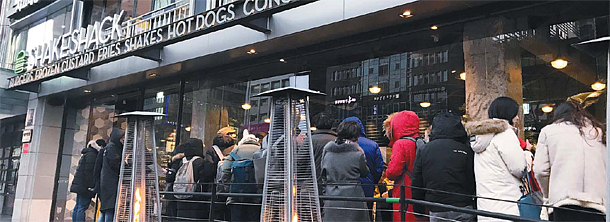[Sponsored Report] Cold snap can’t stop burger fans

People wait in line in front of the Shake Shack Gangnam branch, southern Seoul, amidst freezing weather on Monday. [LEE HA-EUN]
Lately many Western food outlets have been expanding locations in Korea, such as the popular fast-casual restaurant Halal Guys, the widely known Dutch cafe Joe & the Juice and fast food chains such as Subway and Taco Bell. These cater to a double audience: foreigners and Korean locals.
This is achieved by replicating the authenticity of foreign dishes as well as customizing certain items to fit the local palate. This technique, combined with strategic marketing using social media platforms, allows many franchises coming into Korea have seen substantial success.
Shake Shack is a good example, since opening the Gangnam branch has averaged a daily customer count of 3,000.
Its second local location opened in Cheongdam-dong, southern Seoul, in December, and the third location is set to open in northern Seoul in May or June of this year. SPC, the company behind the franchise expansion, announced plans to have a total of 25 stores in Korea by 2025.
One of the key reasons behind the success of these global franchises lies in social media.
Many individuals dining at Shake Shack recalled having first heard of the restaurant through social media, namely Facebook. Boris Cho, an American visiting the Gangnam branch, described how he first heard about it. “Everyone was mentioning Shake Shack via email, social media, even on TV,” he said. “So naturally I had to try it for myself.”
Park Si-hyung, a student who learned of the franchise through the hype on social media, admitted he visited because “All the positive verdicts, the pictures, and the ridiculous line in front of the restaurant must have meant something.”
Another key to its success is an extensive target demographic. As well as curious locals, the restaurant appealed to foreigners with its rich authentic flavor.
“I came because I wanted to see if the local Shake Shack tasted the same as in the States,” said Cho. “I was not let down. It really is exactly the same.”
Similarly, Paul Tillman, an American living in Korea, likes to visit Shake Shack because “It feels like home.”
Sophie Park, a Korean-American who has lived in both Korea and the United States, argues that the popularity of brands like Shake Shack may be connected to the popularity of trends in Korean culture. “I feel like Koreans are especially sensitive to what others think and do,” explained Park. “They want to keep up with the trend.”
Kim Ju-hee, a student at Handong Global University in Pohang, implied that Korean trends were relatively influential, mentioning the honey butter chips fad in 2014 that quickly became a national craze. “I think these restaurants are pretty similar,” she said. “Through a variety of media and social media platforms, these restaurants become ‘cool’ — and then everyone wants to go.”
BY LEE HA-EUN, PARK YEH-RIM [yehrim7@gmail.com ,haeunlee2000@gmail.com]










with the Korea JoongAng Daily
To write comments, please log in to one of the accounts.
Standards Board Policy (0/250자)